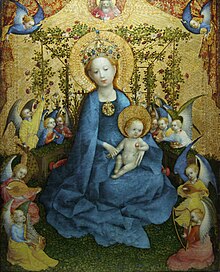Soft style
The soft style is a style in late Gothic painting and sculpture around 1400. Typical examples of the soft style are figures of the Virgin Mary , which are also called “beautiful Madonnas”.
Development towards a soft style
During the development of the soft style , the Prague – Paris axis was particularly important for culture, which can be traced back to the particularly close ties between the Luxembourgers and the French kings. The Roman-German Emperor Charles IV (1346-1378), who came from the Luxembourg family, had set himself the goal of making Prague the artistic center of Central Europe, which he succeeded in doing. For the construction of St. Vitus Cathedral in Prague, Charles IV brought Peter Parler . He worked as an architect and sculptor. He executed the tomb of Ottokar I. Premysl , for which he took 900 silver groschen. The figure of St. Wenceslas in St. Vitus Cathedral also comes from the Parler Circle.
features

Characteristic is the emphasis on the figures' robes, which fall in round, flowing hollows and appear increasingly three-dimensional, and the wide strips of fabric lying on the floor, the edges of which are designed in soft flowing shapes. The delicate, dreamy expression and the graceful figure, paired with detailed descriptions, are also characteristic. The soft style was already developed around 1380 (see André Beauneveu ) and widespread a decade later. “Beautiful Madonnas” were created for almost the entire 15th century, but the later works that are so named no longer belong to the soft style , which ends around 1450. He is being displaced from the Netherlands by new realistic influences. In the fold style, this can be seen in the transition to the "angular style" with hard folds.
Around 1400, clay and artificial stone became the commonly used materials in some art centers because they were less expensive and easier to work with than the other common materials such as natural stone , marble and wood.
The "beautiful Madonnas" are characterized by a relaxed mobility. The close relationship between Our Lady and the Baby Jesus is particularly striking.
The soft style can be found in the works of sign painters, illuminating and sculpture.
See also:
- Beautiful Madonna of Krużlowa
- Master of the Thorner Madonna
- Konrad Kuene van der Hallen , as an important sculptor and Cologne cathedral builder with a soft style.
Terms
The term soft style was created in 1907 by H. Börger and was widely used by Wilhelm Pinder in the 1920s to 30s . Since it is used almost exclusively by German art history, there have been controversial attempts to introduce the substitute term “international Gothic”. This arises from the observation that the soft style was subject to a lively international exchange of forms and ideas and a uniformity that was unique in the history of Europe. The term "beautiful style", which originated in Czech art research, is another synonym for the soft style .
The term "beautiful Madonna" is ascribed to both Pinder (1923) and A. Stix.
Madonna from the Très Belles Heures de Notre-Dame by an unknown artist (around 1402)
"Schöne Hallgartenerin" (around 1415) in the parish church of the Assumption in Hallgarten in the Rheingau
Women under the Cross from the Thomas Altar by Master Francke (around 1424)
Our Lady (approx. 1430) in St. Nikolaus in Veringenstadt
literature
in alphabetical order by authors / editors
- Karl Heinz Clasen: The Master of the Beautiful Madonnas. Berlin and New York 1974. (Reviews on this in: Kunstchronik 1976, pp. 244–255 and Zeitschrift für Kunstgeschichte 1978, pp. 61–92).
- Burkhard Kunkel: The Stralsund Young Madonna as an image of the beautiful Madonna of Thorn? - Considerations on the origin of an image of Mary from a Stralsund perspective . In: Terra sanctae Mariae. Art historical work by the Cultural Foundation of German Expellees 7. Bonn 2009, pp. 257–278.
- NN: Soft Style and Beautiful Madonnas , in: Lexikon der Kunst. Harald Olbrich (Ed.), Deutscher Taschenbuch Verlag, Munich 1991, ISBN 3-423-05906-0
- NN: Soft Style and Beautiful Madonna , in: The large art dictionary by PW Hartmann. Hartmann, Sersheim 1997, ISBN 3-9500612-0-7
- NN: The Parler and the Beautiful Style. European art among the Luxembourgers exhibition catalog Schnütgen-Museum. Cologne 1978. (three volumes, two supplementary volumes).
- Michael Victor Schwarz: Courtly Sculpture in the 14th Century. Development phases and communication channels in the run-up to the soft style = manuscripts for art history in the Werner publishing company 6 (2 parts). Wernersche Verlagsgesellschaft , Worms 1986. ISBN 978-3-88462-905-5
- M. Krenn and Ch. Winterer: With brush and quill pen, history of medieval book painting, WBG, Darmstadt, 2009, ISBN 978-3-89678-648-7




